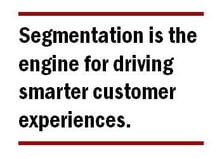Knowing how to understand customers is key to creating a successful customer experience program.
This lack of understanding is one of the most common barriers to being intelligent about your company’s customer experience. When we talk about segments based on this, we’re looking through two primary lenses:
- Needs:What your customers actually want, need and expect from you.
- Value: What your customers are (or may be) worth to your firm.

When most companies talk about segmenting customers, they mean segmenting by value. They divide customers into segments based on actual or potential sales. They strive to understand how much revenue they could get from a given group of customers.
Value segmentation is important from the company’s perspective; it helps your company know which customers it makes sense to focus efforts and resources. It also points toward groups who might be better served with a lower-touch, lower-cost digital strategy.
It’s an important first step. But most companies stop here. You cannot afford to. Why? Value segmentation doesn’t help you understand what one customer needs versus another. The bottom line is that if you don’t segment customers by their individual needs, it will be incredibly difficult to deliver exceptional customer experience, much less remain competitive.
Without A Definitive Understanding Of Your Customers, Everyone In Your Company Is Essentially Flying Blind
When we say definitive, we mean just that. Who exactly is your customer? And what precisely is their value to you over time? Unfortunately, many companies don’t look at customers through the lens of wants and needs. Or, if they do, they often don’t share the information effectively across other silos and groups internally.
Not knowing how to understand customers in this way means you will consistently fail to give them what they want at any given point. As a result, you are virtually ensuring that you will deliver subpar experiences at least some of the time no matter how well you do everything else.
It also means you will fail to grasp opportunities to satisfy or delight them, and will miss otherwise obvious opportunities to increase customer value.
The Cost Of Ignorance Can Be Incredibly High
The most obvious cost is the inability to keep the customers you’ve worked so hard to acquire. In short, not knowing how to understand customers at the individual level makes it hard for your company to effectively give them what they need, when they need it. And when customers don’t get it from you, they’ll get it somewhere else. After all, if you don’t understand your customers, then how can you possibly deliver the kinds of experiences they desire?
And if you don’t know what they’re worth on a customer-by-customer basis, then how will you know whether you are (or aren’t) focusing your limited resources on those that are most important to you?
On the one hand, raising service standards across the board means you can invest significant resources delivering great customer experiences that you’ll never profit from. On the other, lowering service standards means you run the risk of indiscriminately dissatisfying all your customers.
Questions To Ask:
- Do you know what your customers really want and need?
- Is there a shared understanding of who your most valuable customers are and how to meet their needs?
- Do you understand common needs that all of your customers have, as well as the unique needs of each segment?
- Is your customer data integrated and easily accessible across your organization, or is it stuck in silos?
- Do the right employees have access to the right information about your customers?
Steps You Can Take:
- Analyze and summarize the data and “digital breadcrumbs” customer relationships and smart touchpoints generate.
- Integrate “outside in” voice-of-the-customer (VoC) data.
- Use segmentation to predict customer behavior and needs.
- Reorganize business functions modularly, based on segmentation insights and customer needs.
Benefits Your Organization May Expect:
- Significantly improved marketing and sales effectiveness.
- Empowered employees who can make decisions based on the value of your customers and better address customer needs.
- Improved customer experience and strengthened relationships.
- Increased lifetime value of your customers.
You Can’t Deliver Smart Customer Experiences Unless You’re Intelligent About Your Customers
The bottom line is this: To deliver the customized and highly personalized products, services, and experiences your customers increasingly demand, you need a highly efficient lens through which to understand them. Defining your customers both by value and their needs on a segment-by-segment basis provides that lens. Put another way, segmentation is the engine for driving smarter customer experiences.
It also provides the framework for methodically leveraging the massive amounts of data almost every organization of scale gathers on its customers as a result of the electronic breadcrumbs scattered as they interact and transact–by phone, over the Web, through mobile digital devices, and more –with the companies that serve them.
After all, when it comes to serving smart customers, delivering smarter customer experiences is the only intelligent thing to do.

